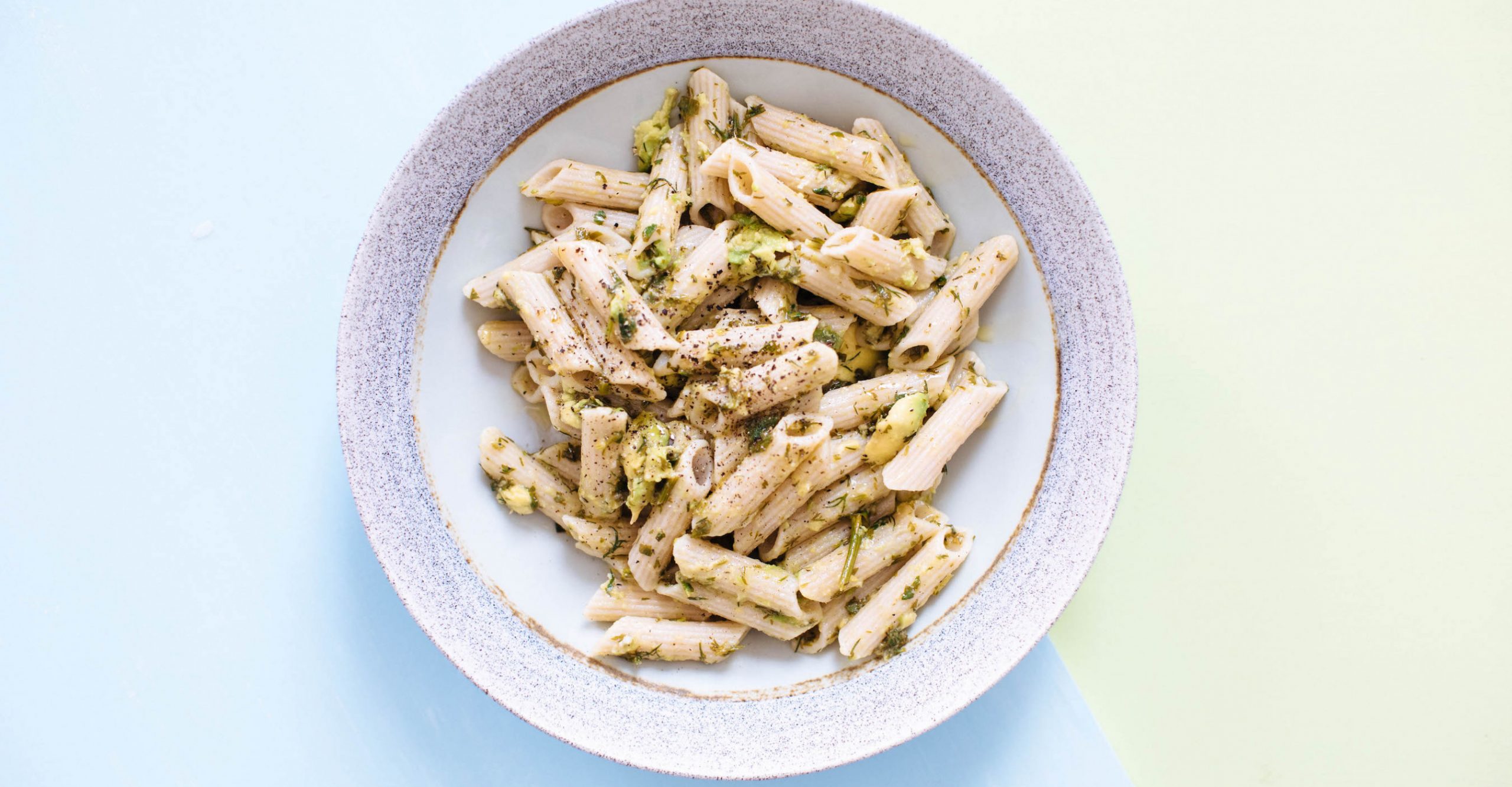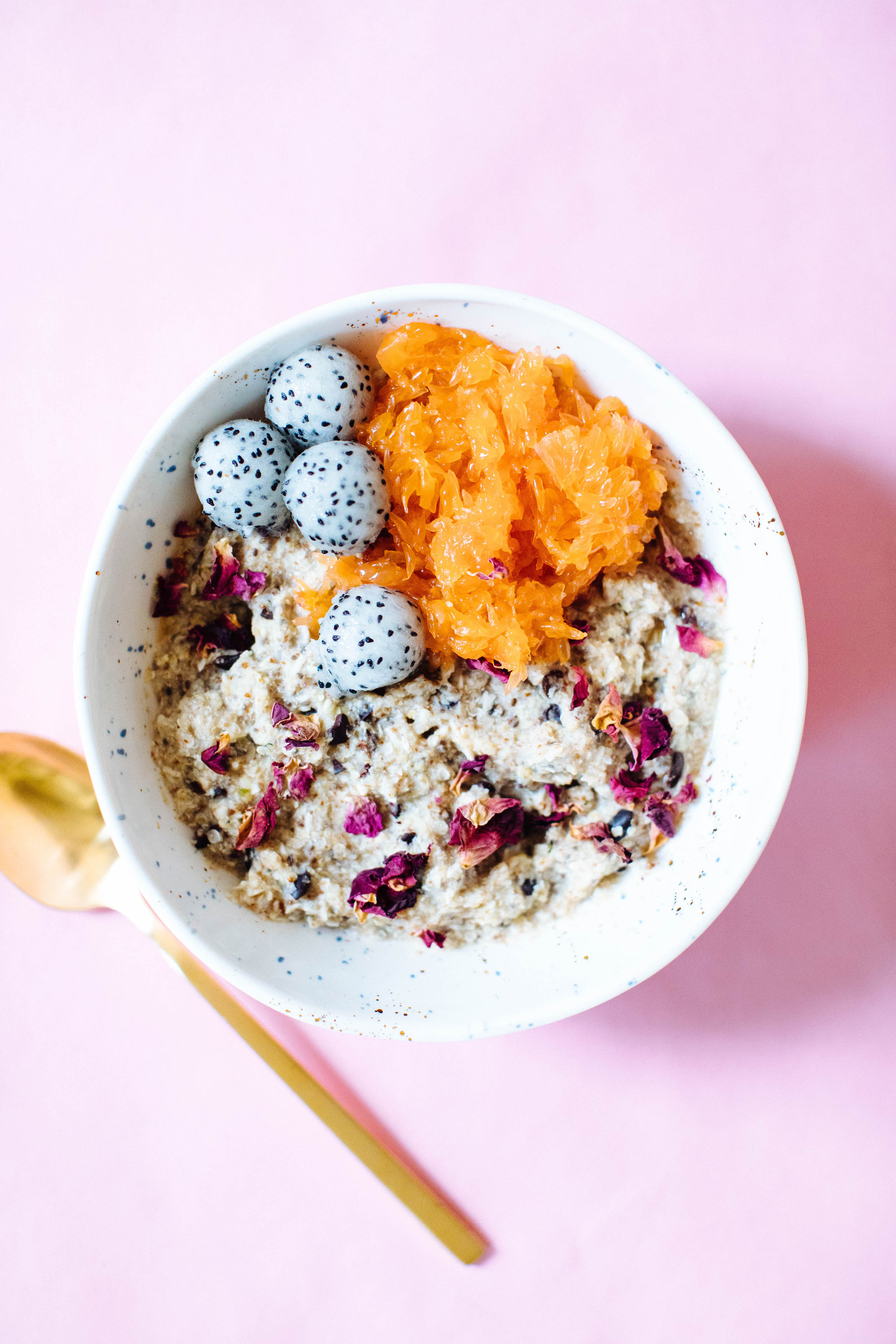Blood sugar spikes and drops can result in a slew of less than ideal symptoms. If you’re wondering whether or not your blood sugar levels are balanced, keep reading!
Do you find yourself craving more sugary or starchy foods? Are you feeling lethargic or experiencing brain fog, headaches, dizziness, or hunger more often than you’d like? These symptoms may be the result of imbalanced blood sugar levels.
Let’s dive into the ins and outs of blood sugar. We’ll chat all about what it is and how you can stabilize your levels to sustain your energy and feel satiated throughout the day!
How Does Blood Sugar Work?
Before we talk about stabilizing blood sugar, it’s important to understand how blood sugar works.
Blood Sugar and Carbohydrates
All carbohydrates — whether from fruits and vegetables or from sweets and cookies — break down to sugar in the body, otherwise known as glucose. In the Foundational Five (the system we teach for building a balanced meal), there’s one primary element that contributes to blood sugar: Starchy and Sugary Carbohydrates.
Carbohydrate intake is what introduces sugar to the bloodstream. The type, timing, and amount of carbohydrates consumed determine how much sugar is introduced to the bloodstream at one time.
More complex, natural sources of carbohydrates (think whole grains, beans, legumes, or fruit) will introduce sugar to the bloodstream at a slower, more gradual rate. Simpler, processed sources of carbohydrates will introduce sugar to the bloodstream at a faster rate.
We also have to take into account whether the carbohydrates were consumed on their own or paired with something else. When consumed alone, the rate of absorption is a bit quicker. Yet when they’re consumed with protein, healthy fat, or fiber, this helps to slow things down a bit.
Why Do We Need Sugar From Carbohydrates?
This sugar (or glucose) from carbohydrates is vital for the body to function appropriately. From muscle contractions to organs that rely on sugar for their energy source, we genuinely need glucose to keep everything running smoothly.
In a nutshell, carbohydrates are the body’s primary source of energy!
But before glucose can be used as energy by the organs, it has to be brought to the cells from the bloodstream. This is where insulin comes into play.
Insulin Turns Sugar Into Energy
After we consume carbohydrates, the pancreas produces a hormone called insulin in response. Insulin’s job is to clear the sugar from the bloodstream. It also determines whether we’re going to use the sugar from the consumed carbohydrates as energy now, or if we’re going to store it for later use.
Think of insulin as a little car that picks up the sugar, carries it from your bloodstream, then drops it off at the cell for it to be absorbed and used as energy.
For example, when there’s too much glucose in your bloodstream, insulin says, “Hey! There’re way too many glucose molecules for me to pick up in my car, please bring some to the liver!”, so your body stores that excess glucose in the liver for later.
Blood Sugar Spikes and Drops
Your blood sugar can spike, drop, fluctuate or remain stabilized. So let’s discuss how this happens and when it happens.
Blood Sugar Spikes
So how and when do blood sugar spikes occur?
Without insulin, the sugar would just hang out and float around in your bloodstream. When insulin either isn’t present or isn’t able to properly do its job, high blood sugar levels, otherwise known as a blood sugar “spike” are the result. This can cause some of those unpleasant symptoms we mentioned earlier, and can also lead to long-term damage.
Additionally, when carbohydrates are frequently consumed alone or are frequently coming from more processed and refined sources, it’s a bit more difficult for insulin to keep up. This can lead to blood sugar spikes as well.
Blood Sugar Drops
Now that we understand high blood sugar, what about low blood sugar?
Because high blood sugar isn’t ideal, you might be thinking low blood sugar is the goal — well that’s not true either. It’s all about balance.
Low blood sugar happens when there’s a surge of insulin or a lack of carbohydrate intake overall.
In the case of a surge of insulin, too much sugar is transported out of our bloodstream. We then start craving things like chocolate or cake to make up for it. The body is essentially saying, “I need sugar to balance out, please!”.
Blood Sugar Fluctuations
In response to the low blood sugar signals from the body, we’re more likely to feed our bodies with sugar. The problem here is things like chocolate and cake fall into that simpler, more processed carbohydrate category. After consuming those food items, our blood sugar shoots right back up.
Over time, this can lead to an endless fluctuation of blood sugar levels, or perpetual spikes and drops.
The goal is to find a balance somewhere between blood sugar spikes and drops. That middle ground prevents us from having excess blood sugar or excess insulin, which helps us to ultimately feel our best.
Signs and Symptoms of Blood Sugar Fluctuations
So how do we know when this whole process is taking place?
When we’re experiencing blood sugar spikes frequently, we’re inevitably experiencing low blood sugar in response as well. The symptoms of low blood sugar are tell-tail signs that your blood sugar is fluctuating frequently.
Common signs and symptoms of low blood sugar are:
- Shaky hands
- Increased heart rate
- Brain fog
- Confusion
- Dizziness
- Irritability
- Anxiousness
- Clammy hands
- Chills
How to Stabilize Blood Sugar
So now that you know why blood sugar is important to be mindful of, here are a few simple tips to use to stabilize blood sugar.
1. Focus on Healthy Fats
Healthy fats take longer to digest than carbohydrates. Therefore when they’re consumed alongside carbohydrates, they slow down the carbohydrates’ rate of absorption. Additionally, fats don’t directly impact our insulin or blood sugar levels.
When consuming starchy carbohydrates, add some healthy fats like nuts, seeds, avocados, or coconut oil to help slow down absorption and prevent a blood sugar spike.
2. Make Sure You’re Getting Plenty of Fiber
Fiber, just like healthy fats, slows down the rate of starchy carbohydrate absorption.
If you’re eating a diet high in whole foods like vegetables, fruits, nuts, seeds, and legumes, chances are you’re getting plenty of fiber. On average, aim for about 25-35g/day. This can also be further individualized depending on your gender, digestive system, and energy intake.
3. Eat Well-Balanced Meals
Aim to eat the Foundational Five at each meal. If you’re not familiar with it, you can download our free guide that shares more about this. To give you a general idea, it’s five simple elements that make up your plate: protein, healthy fats, non-starchy carbohydrates, starchy carbohydrates, and a flavor factor.
While the flavor factor is just there to help make the dish taste great, the other elements are necessary to create a balanced meal with all the nutrients you need, while also stabilizing your blood sugar.
4. Eat Plenty of Protein
I’m sure you’re starting to see a trend here – protein, just like fiber and healthy fat, slows down the rate of carbohydrate absorption.
Because of this, protein (both plant-based and animal-based) can also help you to feel full. Aim the majority of your protein intake to be made up of lean sources of protein. Beans, legumes, nuts, chicken, turkey, tempeh, tofu, and edamame are all great examples of this.
5. Manage Your Stress
Stress can not only trigger a hormonal response and increase levels of cortisol but feeling stressed can also lead to sugar cravings.
Cortisol is a hormone that can be released in response to stress. It also has the ability to pull stored glucose from the liver to increase blood sugar. In times of significant stress, this can be helpful to help an individual “fight” or “flee” from a stressful situation. Yet when stress is prolonged or chronic, glucose can constantly be released from the liver resulting in long-term high blood sugar.
Due to the fact that sugar cravings are heightened when stress is present, consumption of sugar is often increased. This of course is going to contribute to elevated and imbalanced blood sugar levels.
The moral of the story, be mindful of stress! You can try out some of these stress-reducing strategies here.
6. Get a Good Night’s Sleep
We all know how important sleep is. But think about what happens when you don’t get enough of it – we tend to reach for sugar-laden foods and beverages to increase our energy and help us get moving!
Next time, don’t grab the sugar. Instead, start by analyzing your sleep patterns.
Learn To Eat Balanced Meals With Ease To Stabilize Your Blood Sugar
Sign up to watch my free masterclass today, where you’ll learn about the #1 Habit That Keeps You Struggling With Your Weight and your Relationship With Food — And How To Break Free From The Diet And Food Obsession Starting Now.
You don’t need to stress and obsess about food. There is a better way, and yes it’s possible to cultivate a positive relationship with food! Join this free balanced eating masterclass to learn how.
Watch The Free Masterclass
The post How Your Blood Sugar Impacts How You Feel and How to Stabilize It appeared first on Nutrition Stripped®.
Erica Carneglia


Comments
Post a Comment